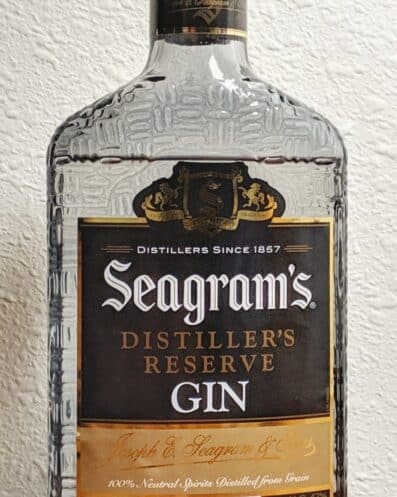Building off of the Seagram’s line, Seagram’s Distillers Reserve is their higher proof “upscale” offering. Whereas previous bottles in the line were a bit higher proof (around 102), the current edition is slightly tamer at 47% ABV.
The mythos is that Seagram’s master distiller selects the barrels “richest in flavor,” and those are the ones selected for the reserve line.
Tasting Notes
The nose reminds me of Seagram’s extra dry. But whether due to the higher strength or a more intense botanical blend— Seagram’s Distillers Reserve does have a more intense aroma.
Heavy citrus and orange initially on the nose. It has a bitter orange character to it, in addition to a slight jammy marmalade facet. Dry juniper persists throughout. It’s quite classic and quite— well— it’s Seagram’s.
To the palate, Seagram’s Distillers Reserve has a touch more of that citrus character on the palate than the Extra Dry. It’s less candy-like in this expression and more of a robust bitter orange— not all that dissimilar from Chase’s Seville Orange Gin.
Juniper is heady and prominent throughout. It’s present early, dominant mid-palate and continues to provide a strong pine-forward backbone to the finish. The finish is where a hint of spice pokes through. Coriander, a hint of cinnamon citrus tea, and lingering sweet lemon rind provide depth and length.
The finish is longer and brighter. Again like gins that scale up for their Navy Strength versions, Seagram’s Distillers Reserve feels stronger botanically and spirit-wise.
Cocktails
With the stronger proof and more botanical punch, Seagram’s Distillers Reserve is a better mixing gin than their flagship Extra Dry Gin. In fact, due to its low price alone (sub $20), Seagram’s Distillers Reserve is a better deal. Though the price per ounce is slightly higher than the dry, Seagram’s Distillers Reserve is a superior product for mixing. Bartenders take heed.
It works well in a Gin and Tonic with a nice citrus/juniper punch. It’s equally at home in a Gin and Juice as it is in an upscale Last Word.
Overall, Seagram’s Distillers Reserve
Quintessentially classic and Quintessentially Seagram’s— Seagram’s Distillers Reserve is a higher proof and better mixing alternative to Seagram’s extra dry. For value and ABV alone, I’m surprised this gin doesn’t have a wider availability and bigger fan base.
I wholeheartedly recommend this gin as an alternative to other Seagram’s offerings or as a better citrus forward gin with classic character. In fact, New Amsterdam‘s newest offering, their London Dry Gin, has a lot in common with Seagram’s Distillers Reserve.


I´do not understound declare about principl of the “reserve”. Please I´want more about it. Here exist a true way questions to as to as plus answeres. P.
– I´am sorry, it is crazy all from me, I´am stop it this mystakes, please sorry. Thank you.
Is the flavoring “botanicals” or “essences”? I can’t get a straight answer.
Legally speaking in the US it is categorized as a “distilled gin” which means “…juniper berries and (optionally) other aromatics or their extracts, essences or flavors added to mash prior to distillation.” Source: https://www.ttb.gov/images/pdfs/spirits_bam/chapter7.pdf
But as far as I am privy too, while it is all distilled, they are indeed botanicals in this instance— although as I said in the definition, technically it could still be a distilled gin with some of the botanicals added as essences before distillation.
Hope that helps, wish I had more for you.
Rough… I wanted to like it, and it does have some redeeming qualities, but something about the way it’s processed is just rough, there’s no other way to say it. It makes me feel like I’ve been drinking poison. In the same price range I’d rather Gordon’s any day, and any more expensive and you’re already at much better gins like Beefeater or Broker’s or Bombay Dry. The comparison to New Amsterdam is accurate and not complimentary, it’s not balanced and it tastes of chemicals even in a good tonic like Fever Tree. I poured most of it away.